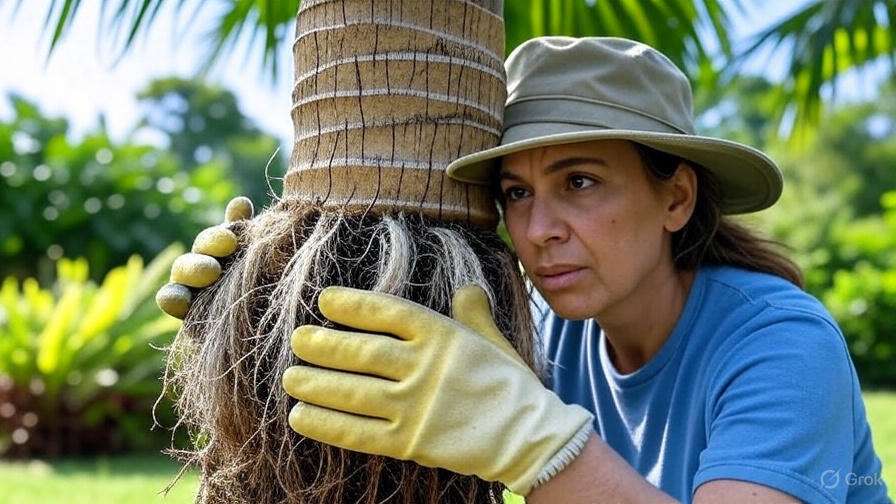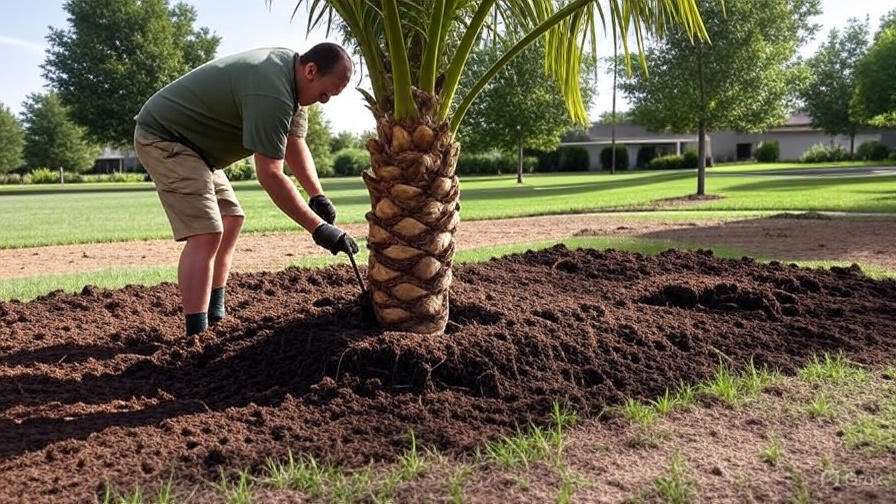
Understanding Palm Tree Roots: How to Manage and Protect Them for Healthy Growth
Palm trees are a symbol of tropical paradise 
In this article, we’ll explore everything you need to know about palm tree roots — from how they grow to the best ways to protect and manage them. Whether you’re a seasoned landscaper or a palm tree enthusiast, understanding these roots will ensure your palm trees stay healthy and strong for years to come. Ready to give your palms the care they deserve? Let’s dive in!
Table of Contents
ToggleThe Role of Palm Tree Roots in Tree Health 
Palm tree roots are an essential part of the plant’s overall health, providing stability, nutrients, and water necessary for growth. Understanding the role of these roots is key to keeping your palm tree thriving for years to come. Let’s break down what palm tree roots do and how you can care for them to ensure your tree stays healthy and vibrant.
1. Stability and Anchoring 
Palm tree roots are unique compared to other trees. Instead of a deep taproot, palms have a dense network of fibrous roots that spread horizontally near the surface. These roots are designed to anchor the tree securely in place, preventing it from toppling in strong winds. If the root system is damaged or compromised, the palm can become unstable, making it more vulnerable to storms and other environmental stressors.
Tip: Avoid disturbing the root zone during landscaping or construction projects to maintain the tree’s stability.
2. Nutrient and Water Absorption 
Palm roots are responsible for absorbing water and essential nutrients from the soil. Unlike some trees, palms rely heavily on the surface layer of soil for these nutrients. If the roots cannot access the necessary minerals, the tree may show signs of nutrient deficiencies such as yellowing leaves or stunted growth.
Tip: Ensure your palm tree is planted in nutrient-rich, well-drained soil. Regularly water your palm, but avoid overwatering, as this can lead to root rot.
3. Root Health Affects Growth and Appearance 
Healthy roots are directly linked to the tree’s growth and overall appearance. If the roots are damaged, whether from poor soil conditions, pests, or physical injury, the tree’s growth will slow down, and the leaves may begin to wilt or turn brown.
Tip: Inspect the root zone periodically. If you notice poor drainage or root rot (which often appears as mushy or discolored roots), consider repotting or improving the soil drainage.
4. Preventing Root Damage 
Palm trees, especially young ones, can be sensitive to root damage. Physical injuries, such as cuts or bruises to the roots, can hinder their ability to take in nutrients and water. Additionally, pests like root nematodes can cause harm to the root system, affecting the tree’s health.
Tip: Mulch around the base of the tree to protect the roots from extreme temperatures and pests. If planting a new palm, be gentle with the roots to avoid causing any harm.
5. Maintaining a Healthy Root System 
To ensure your palm tree’s roots stay healthy, provide them with the right environment. Well-drained soil, consistent watering, and proper sunlight are crucial for root development. Avoid planting palm trees too deep, as this can stunt root growth and cause issues with nutrient uptake.
Tip: During planting, make sure the top of the root ball is level with or slightly above the surrounding soil. This promotes healthy root growth and prevents water from pooling around the roots.

How to Assess the Health of Palm Tree Roots 
Palm trees are stunning additions to any garden or landscape, but like all plants, their roots need attention to stay healthy. Healthy roots are the foundation of strong, thriving palms, so it’s crucial to assess their condition regularly. Here’s how you can tell if your palm tree’s roots are in good shape and what you can do if they’re not.
1. Look for Signs of Root Damage or Rot 
A healthy palm tree will have strong, vibrant roots. However, if you notice any of the following, it could be a sign of root trouble:
- Yellowing or wilting fronds: This is often the first sign of root issues. If your palm is showing signs of stress, check the roots.
- Soft, mushy roots: Healthy roots are firm and white. If they feel soft, brown, or slimy, your palm may have root rot.
- Foul odor: A strong, unpleasant smell from the soil or roots often indicates rot caused by overwatering or poor drainage.
2. Check for Root Circling 
Sometimes, palm tree roots grow in circles around the root ball, especially if the tree has been planted in a container for too long. This is called root circling, and it can strangle the roots over time, reducing water and nutrient intake. To check for this, carefully dig around the base of the tree and look for roots growing in a circular pattern. If you find any, gently cut them to allow the roots to spread properly.
3. Digging and Inspecting the Root System 
If you’re unsure about the health of your palm tree’s roots, a careful inspection is the best way to go. Here’s how to do it:
- Dig around the base of the tree: Gently loosen the soil about 6 to 12 inches from the trunk.
- Look for root damage: Healthy roots should be white or light tan. Any dark, mushy, or slimy roots are unhealthy and should be trimmed away.
- Check root spread: Palm roots typically grow out, not deep. Ensure they’re spreading outward and not confined to a small, compact space.
4. Monitor Watering and Drainage 
Overwatering or poor drainage can lead to root rot, so it’s essential to check how water is interacting with the soil. Ensure the ground around your palm tree drains well, and avoid letting water pool near the roots. Consider adjusting your watering schedule based on the season and the type of palm.
5. Look for Root Pests 
Root pests like nematodes, weevils, and termites can damage the root system. If your palm tree is showing signs of stunted growth or unusual yellowing of fronds, check for pests. These pests can often be seen as tiny holes or damaged areas on the roots. Treating infestations early is key to preventing root damage.
6. Test the Soil Around the Roots 
Sometimes the issue isn’t the roots themselves but the soil around them. Poor soil quality, compacted soil, or nutrient imbalances can all affect root health. Use a soil test kit to check the pH, nutrient levels, and drainage capacity of the soil. Adjusting the soil with compost, mulch, or soil amendments can help support healthy roots.
By regularly assessing the health of your palm tree’s roots, you can ensure that it grows strong, healthy, and vibrant. Remember, healthy roots mean a healthy palm! 

Best Practices for Managing Palm Tree Roots 
Managing palm tree roots is essential for maintaining the health of your palm tree and protecting your landscape. Whether you’re planting a new palm or caring for an established one, following these best practices can help you keep the roots strong, healthy, and free from damage. Here are some practical tips to guide you:
1. Choose the Right Planting Location 
Before you even plant your palm tree, it’s important to select the right spot. Make sure the location offers enough space for the roots to grow without being restricted. Palms generally need room to spread out, as their roots can grow wide and deep. Avoid planting them too close to buildings, walkways, or other trees that may crowd the roots.
2. Plant at the Right Depth 
When planting a palm tree, ensure the root ball is level with the surrounding soil. Planting too deep can cause root rot, while planting too shallow exposes the roots to the elements. Aim for a depth where the base of the trunk is slightly above ground level to encourage proper root development.
3. Avoid Root Damage 
Roots are sensitive, and damaging them can stunt the growth of your palm tree. When digging around your palm, use care to avoid cutting or disturbing the roots. If you’re transplanting a palm, dig up as much of the root system as possible to minimize stress.
4. Use Mulch Wisely 
Applying a layer of mulch around the base of your palm tree helps retain moisture, regulate temperature, and suppress weeds. However, avoid piling mulch directly against the trunk, as this can cause rot. Keep the mulch a few inches away from the trunk, and maintain a shallow layer to encourage healthy root growth.
5. Water Properly 
Palm tree roots need consistent moisture, but they also require good drainage. Overwatering or letting the roots sit in stagnant water can lead to root rot. Water your palm deeply but infrequently, allowing the soil to dry out between waterings. Ensure your soil drains well to avoid waterlogging the roots.
6. Prevent Root Compaction 
Heavy foot traffic or excessive equipment use near the base of a palm tree can lead to compacted soil, which hinders root growth and oxygen flow. Avoid walking or placing heavy objects around the root zone. If you must create paths, consider using stepping stones or raised walkways.
7. Prune Carefully 
While palm trees generally don’t require heavy pruning, removing dead or damaged fronds can help the tree focus its energy on healthy growth. When pruning, avoid cutting into the crown or damaging the growing point at the top of the tree, as this can harm the roots and overall health.
8. Monitor for Pests and Diseases 
Roots can be affected by pests like root mealybugs or fungal diseases. Regularly inspect your palm tree for signs of pest damage, such as discolored or weakened fronds. If you spot an issue, treat it promptly with appropriate organic or chemical solutions to protect the roots.
9. Fertilize Properly 
Fertilizing your palm tree helps nourish its roots and encourages strong growth. Use a balanced fertilizer designed for palms, and avoid over-fertilizing, which can damage the roots. Apply fertilizer in the growing season, following manufacturer instructions for the correct amount and frequency.
10. Give Roots Room to Grow 
As your palm tree matures, its roots will continue to expand. Be mindful of nearby structures, fences, and other plants. If necessary, consider root pruning or installing root barriers to direct growth away from sensitive areas. Prune the roots carefully to avoid causing undue stress to the tree.
By following these best practices, you can ensure your palm tree’s roots remain healthy and strong, supporting overall tree vitality and longevity. Regular care and attention will help your palms thrive for years to come!

How to Protect Palm Tree Roots 
Palm trees are beautiful additions to any landscape, but to keep them healthy and thriving, it’s crucial to protect their roots. Palm tree roots are delicate and can be easily damaged, which may lead to stunted growth or even tree death. Here’s how you can protect those roots and ensure your palm tree flourishes for years to come.
1. Provide Proper Watering 
One of the most important factors in protecting palm tree roots is ensuring they receive the right amount of water. Palm roots are shallow, meaning they dry out quickly if not watered properly. However, overwatering can suffocate the roots and lead to rot.
Tip: Water deeply and infrequently. This encourages the roots to grow deeper and more resilient. Aim to water early in the morning or late in the evening to minimize evaporation.
2. Mulch to Retain Moisture 
Mulching around your palm tree can work wonders in protecting the roots. A layer of organic mulch, such as wood chips or bark, helps retain soil moisture and regulate temperature. It also protects the roots from extreme heat or cold.
Tip: Apply a 2-3 inch layer of mulch around the base of the tree, making sure to keep it a few inches away from the trunk to avoid rot.
3. Avoid Compaction 
Soil compaction can be a major issue for palm tree roots. It limits the flow of oxygen and water to the roots, which can stunt growth. Avoid walking or driving over the soil near the palm, and be cautious with any heavy equipment in the area.
Tip: If you’re doing garden work or construction near the tree, use protective boards or mats to distribute weight and prevent the soil from compacting.
4. Prune with Care 
Pruning is essential for maintaining the health of your palm tree, but it’s important not to damage the roots when doing so. Be careful when trimming surrounding plants or grass, as the roots may be closer to the surface than you think.
Tip: Use sharp, clean tools, and avoid cutting too close to the root zone. A professional arborist can assist if you’re unsure about safe pruning practices.
5. Choose the Right Location 
Palm trees need space to grow, both above and below ground. When planting a palm tree, select a spot where the roots can spread out comfortably without obstruction. Avoid planting near structures, other trees, or hardscaping materials that may limit root growth.
Tip: Plant your palm tree at least 6-10 feet away from walls, fences, or other trees to give the roots enough room to spread out and establish themselves.
6. Protect from Pests and Disease 
Pests and diseases can weaken the roots of your palm tree, making it harder for them to absorb water and nutrients. Regularly inspect your tree for signs of insect infestations or fungal growth near the base.
Tip: If you notice pests, consider using a natural pesticide or consulting an expert for advice. Keep the area around the tree clean and free from fallen debris to reduce the risk of disease.
7. Be Cautious with Fertilization 
While fertilizing is important for palm health, too much fertilizer can harm the roots. Excess nutrients can lead to root burn or imbalance, affecting the tree’s overall health.
Tip: Use a slow-release fertilizer formulated for palms, and apply it according to the manufacturer’s guidelines. It’s best to fertilize during the growing season (spring and summer) for optimal results.
8. Avoid Root Disturbance 
If you’re working around the tree, be cautious not to disturb the root system. Digging or digging around the tree can cause significant harm to the roots. Always check for roots before starting any excavation or landscaping work near the tree.
Tip: Mark the area around your palm tree to avoid accidental damage. If you need to dig, do so carefully and at least a foot away from the tree’s trunk.
By following these simple, actionable steps, you can ensure your palm tree’s roots stay protected, leading to a long, healthy life for your palm tree.

Troubleshooting Common Palm Tree Root Problems
Palm trees are beautiful, low-maintenance plants, but they can face root-related issues that impact their health and growth. If you’ve noticed your palm tree isn’t thriving like it used to, it might be due to problems with its roots. Here are some common issues and how to solve them:
1. Root Rot 

Problem: Root rot occurs when the roots are waterlogged and don’t get enough oxygen, causing them to decay. This is often due to overwatering or poor drainage.
Solution:
- Ensure the soil has good drainage. If the soil is heavy or compacted, consider repotting the palm or improving drainage with gravel or sand.
- Water the palm tree only when the top 1-2 inches of soil feel dry. Avoid letting the tree sit in standing water.
- Trim off any rotting roots with sterile scissors and repot the tree in fresh, well-draining soil.
2. Compacted Roots 
Problem: Roots that are restricted by compacted soil or pots that are too small can stunt growth and make it difficult for the tree to absorb nutrients and water.
Solution:
- If your palm is in a pot, ensure the pot is large enough to accommodate its root system. Repotting into a slightly bigger pot will give the roots room to grow.
- If your palm is planted in the ground, loosen the surrounding soil around the roots with a garden fork. Be careful not to damage the roots while doing this.
3. Root Exposure 
Problem: Over time, roots may become exposed due to soil erosion or improper planting depth. Exposed roots can dry out or become damaged by environmental stressors like sun or temperature changes.
Solution:
- If you notice exposed roots, cover them with a thin layer of mulch to protect them from the sun and help retain moisture.
- Avoid planting your palm too shallow. When planting a new palm, make sure the root ball is level with the ground surface.
4. Invasive Root Growth 
Problem: Palm trees, especially larger species, can have aggressive root systems that spread and interfere with nearby structures, pipes, or other plants.
Solution:
- Regularly inspect the root zone for any encroachment on sidewalks, driveways, or other structures.
- If the roots are growing into areas they shouldn’t, you may need to install root barriers around the palm to direct growth downward.
5. Nutrient Deficiency 
Problem: Palm trees with unhealthy roots may not be able to absorb enough nutrients from the soil, leading to yellowing leaves or stunted growth.
Solution:
- Apply a slow-release, palm-specific fertilizer to ensure your tree gets the nutrients it needs.
- Make sure the tree’s roots aren’t competing with nearby plants for nutrients. If necessary, consider thinning out surrounding vegetation.
Tips for Preventing Root Problems:
- Water correctly: Overwatering and underwatering can both harm roots. Stick to a consistent watering schedule.
- Use proper soil: Well-draining soil helps prevent root rot and allows roots to thrive.
- Monitor tree health: Regularly check for signs of stress such as wilting, yellowing leaves, or stunted growth. Early intervention can prevent root problems from worsening.
By recognizing and addressing these common palm tree root problems, you can ensure your palm stays healthy, strong, and vibrant 

Conclusion
Caring for your palm tree roots is the key to ensuring strong, healthy, and resilient palms. By understanding the vital role that roots play in the overall health of your tree, you can take proactive steps to protect them from damage and promote steady growth. From proper planting techniques to managing water and nutrients, each practice contributes to the vitality of your palm tree’s root system.
Remember, healthy roots lead to strong trunks, vibrant fronds, and a palm that can withstand the challenges of its environment. So, take the time to check your palms regularly, water correctly, mulch effectively, and stay vigilant against pests and diseases.

By following the expert tips and strategies shared in this guide, you’re well on your way to creating a thriving palm tree landscape. 
Start implementing these root care practices today and watch your palm trees grow stronger and healthier than ever!
Frequently Asked Questions(FAQ)
How deep do palm tree roots grow?
Palm tree roots are typically shallow but spread widely. Most palm trees have roots that grow to a depth of 3-5 feet, depending on the species and soil conditions. Their roots are usually more horizontal than deep, allowing them to absorb nutrients and water near the surface.
How can I tell if my palm tree roots are unhealthy?
Unhealthy palm tree roots often appear brown, mushy, or foul-smelling. Signs of root issues include yellowing or wilting leaves, stunted growth, or the tree leaning to one side. If you notice these symptoms, it’s important to check the roots for damage or rot.
Why are my palm tree leaves turning yellow?
Yellowing palm tree leaves can be a sign of poor root health, usually caused by overwatering, root rot, or nutrient deficiencies. Check the roots for signs of rot and ensure the tree is getting the right amount of water and nutrients to resolve this issue.
Can I plant a palm tree in clay soil?
While palms can grow in clay soil, it can cause drainage issues, leading to root rot. To improve clay soil for palm trees, mix it with organic matter like compost to improve aeration and drainage, ensuring the roots don’t become waterlogged.
How often should I water my palm tree?
Palm trees generally require deep watering once a week. In hotter climates or during dry spells, you may need to water more frequently. Ensure the soil is well-draining to prevent water from sitting around the roots, which could cause rot.
How can I prevent palm tree root damage from pests?
To prevent root damage from pests like root weevils, maintain healthy soil, avoid overwatering, and regularly check the roots for signs of pests. If you spot pests, treat them with insecticidal soap or natural remedies like neem oil to keep the roots safe.
Is it okay to prune palm tree roots?
Pruning palm tree roots should only be done if absolutely necessary. Removing too many roots can weaken the tree. If pruning is needed, focus on cutting back dead or damaged roots, and avoid cutting healthy, vital roots that support the tree’s overall growth.
Why is my palm tree leaning?
A leaning palm tree is often a sign of damaged or shallow roots. It may also occur due to poor soil or root rot. To correct this, stabilize the tree with staking, check the root system for damage, and improve soil conditions to support better root growth and stability.


